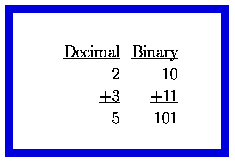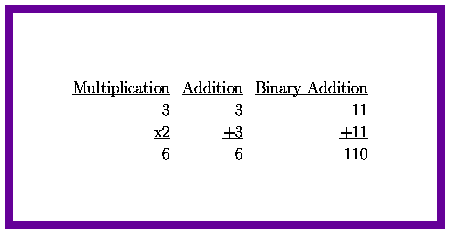
A partial equivalence table between decimal and binary numbers is shown below.
| Decimal ___Binary |
|---|
| ___0 ________0___ |
| ___1 ________1___ |
| ___2 _______10___ |
| ___3 _______11___ |
| ___4 ______100___ |
| ___5 ______101___ |
| ___6 ______110___ |
| ___7 ______111___ |
| ___8 _____1000___ |
| ___9 _____1001___ |
As you can see binary numbers are constructed using only two digits. As you might imagine, must of us humans find working with binary numbers a strain.
For future reference we need to define a computer bit, byte, and word. A bit is a single 0 or 1. A byte is a string of 8 bits. The number of bytes in a word varies between 2 and 8, but 8 byte words are becoming increasingly common. Before bytes were designated, a string of six bits defined a character. By shifting from six to eight bits to define a character, IBM was able to define 4 times as many characters in the new character size and at the same time place the competition at a disadvantage.
Using the binary number system we can perform all arithmetic operations
1.) Addition

2.) Multiplication:

Note: Multiplication can be performed by repeated addition.